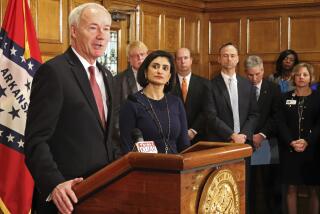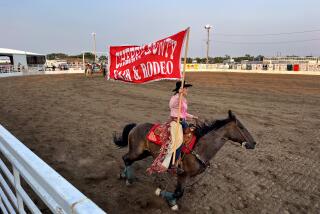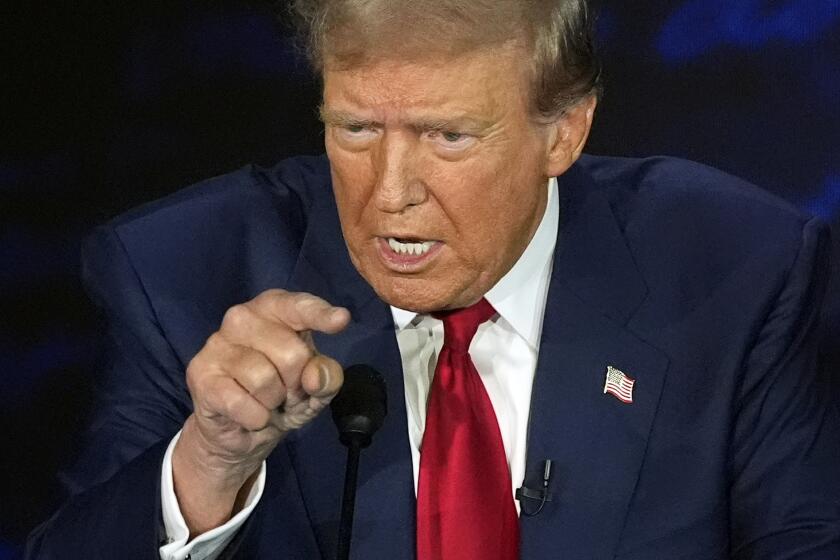Health Problems Tough to Reform in Rural Areas
- Share via
LAKE PRESTON, S.D. — One by one, the businesses that once gave this town its vitality have vanished--the meat market, the farm implement dealer, a grocery store, two car dealerships.
But the hardest blow came three years ago, when Lake Preston’s little hospital lost a 30-year struggle to stay open and the town’s only doctor moved clear across the state. Now a physician makes it through town only once a week, and a nurse practitioner runs the Lake Preston Clinic the rest of the time.
For the 663 people who still live here--many of them old and often sick--treatment as simple as an X-ray is at least 35 miles away. “If it means they have to drive a great distance, they just don’t have health care,” said Carol Arne, Lake Preston’s nurse practitioner.
It is in places like this where President Clinton’s health care reform initiative will confront some of the harsh realities of a failing system. Many in this state say they fear that the plan simply cannot work in such a vast and sparsely populated place.
Lake Preston’s tale is one that Sen. Thomas A. Daschle (D-S.D.) hears again and again as he drives past great stretches of frozen cornfield, stopping at one farm town after another. Fully two-thirds of South Dakota’s counties have been designated by the federal government as medically underserved. What care there is comes dear: The state’s citizens rank seventh nationally in the percentage of their income they spend on health.
Daschle says he is convinced that the Administration’s reforms can go far toward restoring rural America’s crumbling medical network. As point man on a Senate health care task force and a member of the committee with primary jurisdiction over the issue, Daschle is one of Clinton’s most important allies on Capitol Hill.
“There’s an inevitability to health care reform,” the senator recently told a business group in Watertown. “The question is how good will it be.”
Clinton’s proposal gambles that by banding together into health alliances, consumers can gain enough clout to bring costs into line while improving both quality and access to care. But those assumptions of scale, centralization and competition could fall apart in South Dakota, where a population the size of the Fresno area is scattered across more than 77,000 square miles.
As one constituent demanded of Daschle at a meeting in Sioux Falls: “How’s it going to work if nobody wants to practice in Pukwana?”
Few here have much faith in anything that comes to them from Washington.
“In South Dakota, there is a healthy skepticism about the ability of Washington to design any program that meets the unique needs of rural areas,” said state Secretary of Health Barb Smith, a Republican who was part of the Clinton health care task force but who now has strong reservations about the resulting plan.
In principle at least, much in the Clinton plan is winning enthusiastic praise from most rural health experts and advocates.
“I think health care reform presents tremendous opportunity for rural areas,” said Ira Moscovice, director of the University of Minnesota’s Rural Health Research Center and an adviser to the Clinton health care effort. “For the first time, rural lobbyists and advocates were at the table from the beginning with respect to development of the health care plan. Rural concerns were considered.”
The plan’s promise of universal health insurance coverage is particularly important in rural areas, where people are less likely to have private insurance or Medicaid. Similarly, farmers who now buy their own health insurance will be among the major beneficiaries of the proposal to make those premiums completely tax-deductible for the self-employed.
The plan also envisions funds to expand rural clinics, tax credits and other incentives for those who practice medicine in rural settings, and technological links--such as satellite hookups--between country clinics and city medical centers.
But perhaps the greatest boon to rural communities would be the plan’s expansion of the role of primary care providers--not just family practice doctors but also nurse practitioners, nurses and physicians’ assistants known as P.A.s.
Lake Preston’s lifeline is Arne, a 49-year-old nurse practitioner and P.A. who runs the little clinic that stands alongside what used to be the hospital.
Arne is popular and well respected among her patients, but jobs like hers--she works alone and is on call 24 hours a day--invite burnout. Arne, who has been in Lake Preston since April, is the third P.A. to take over the clinic since the hospital closed.
Nurse practitioners and physicians’ assistants, who have less training than doctors, are prohibited by law from performing complicated medical procedures. For heart attack victims, Arne said she can do nothing more than “stabilize them and ship them off.”
Still, she added, “I can diagnose and treat probably 90% of what comes in the door.”
Nationwide, more than 600 rural hospitals have shut down since 1980, often taking their town’s last doctors with them. But only in the last few years have non-physician health care providers won wide acceptance in rural areas.
“As long as people had a thought that they could have a doctor, they wouldn’t go to a P.A.,” Daschle said.
Lake Preston seems to have adjusted. “Everybody’s well satisfied,” said John Sittner, former publisher of the town’s weekly newspaper. “We’re realistic, and that’s all we have. Just between you and me, I think that’s about all rural America can hope for.”
A practice like Arne’s demands ingenuity as well as healing skills. Whenever she can, she wheedles visiting pharmaceutical company representatives out of extra free samples so that she can give them to people who might otherwise have to choose between taking their drugs and buying food. But lately, fewer and fewer salespeople are even bothering to call at her isolated clinic.
She said she does hear from medical headhunters three or four times a week, inquiring whether she is interested in openings in other rural communities. Turnover in the field is high and, even with the incentives that would be built into the Clinton plan, many are skeptical that an adequate supply of primary care providers can be had.
Indeed, some have warned that a shift away from specialization could actually make the shortage worse. Little country clinics may not be able to compete with the wealthier urban health maintenance organizations and hospitals for the limited supply of primary-care providers.
“It’s hard to figure out how you’re going to pay someone $55,000 when the clinic is only making $40,000,” said Dr. Michael Hogue, a physician at Sioux Falls’ Central Plains Clinic.
Hogue says he has had a difficult time finding someone to fill a P.A. job that has been open for three months at a satellite clinic in Beresford, a town of 1,800 people that is 30 miles south of Sioux Falls. Except for the half-day a week that Hogue visits, two P.A.s are the town’s only health care providers.
“You’re trying to compete against a clinic that’s going to pay top dollar or better the first year,” Hogue said. “A position like this--two or three years ago, we would have had 10 or 15 applicants. This year, we’ve had three. A lot of it is just people positioning themselves for what they know is coming.”
Rural health care providers say they are also concerned about the Administration’s plan to curb the growth of Medicare spending by $124 billion over six years to help finance the reform effort.
State Secretary Smith noted that some of the state’s hospitals depend on the federal program for as much as 80% of their revenues. Noting that federal formulas already penalize non-urban providers, she said the additional reductions would amount to “a double whammy” for hospitals that already are struggling to keep their doors open.
She said she also worries that Clinton’s proposal to require employers to pay the lion’s share of their workers’ health insurance premiums could cut especially deep in rural areas, where businesses tend to be small and struggling.
Another big question is whether the sprawling private health networks envisioned under the Clinton plan will even want to do business in states like South Dakota, if they are forced to accept everyone, as Clinton has proposed.
Today more than 300 companies offer health insurance in South Dakota, but they focus on the state’s only two urban areas, Sioux Falls and Rapid City. It is far from clear whether many will view it as profitable if they had to offer equal benefits in the sparsely populated rural areas as well.
Many in rural South Dakota say they fear that under the Clinton plan they may lose what few health care choices they have now. “If we have only one (health maintenance organization) to take care of the whole state, maybe the only hospital we’ll be able to go to is Sioux Falls, 90 miles away,” Sittner said.
That is why many say they believe that small states may ultimately be forced to turn to the so-called single-payer system, a government-financed health care system similar to Canada’s.
That would be fine with Sittner, who has a brother-in-law in Canada. “He’s perfectly happy with it,” Sittner said. “It looks to me like single-payer is the only one that will give what we want specifically in the small town. We want choice in doctors.”
But others, repeating horror stories of long waits for treatment north of the border, note that Canada has been known to ship its citizens to the United States when they need high-tech medicine.
And then there is South Dakota’s inherent mistrust of anything that smacks of too much government. “Single-payer is clearly more efficient than anything else that’s out there. But politically, I don’t think the state’s ready for it,” Daschle said.
South Dakota’s other senator, Republican Larry Pressler, says Clinton’s plan does not improve on the current system. At least 80% of the state’s residents, he estimates, will end up paying more for worse care.
Republican Gov. Walter D. Miller, equally critical, warns that it could leave the state holding the bag for expensive new entitlements created in Washington.
Ultimately, the University of Minnesota’s Moscovice said, the fate of health care reform in rural America will hinge on how it is carried out by state governments and health care providers. “The issue is whether we can get urban providers and health plans sensitive to local concerns,” he said. “It’s got to be a win-win scenario, or it’s not going to play out very well in rural America.”
More to Read
Get the L.A. Times Politics newsletter
Deeply reported insights into legislation, politics and policy from Sacramento, Washington and beyond. In your inbox twice per week.
You may occasionally receive promotional content from the Los Angeles Times.










